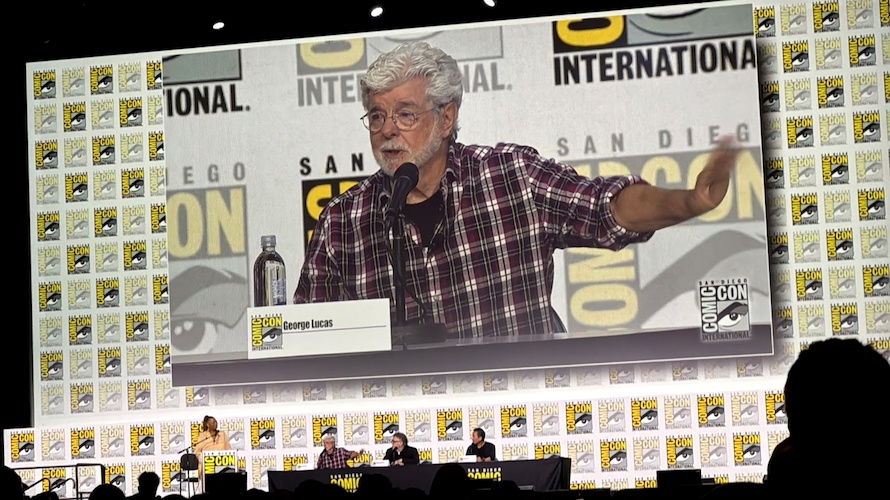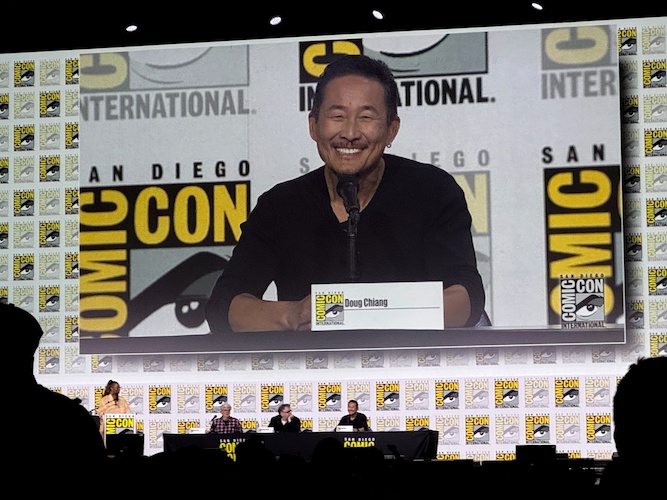SDCC 2025 Panel Recap: George Lucas Makes First-Ever Comic Con Appearance in Promotion of His Upcoming Museum
Yesterday morning, San Diego Comic-Con 2025 attendees gathered in Hall H for the convention’s first-ever appearance by Lucasfilm founder and Star Wars creator George Lucas, who was there to promote his highly anticipated Lucas Museum of Narrative Art.
The panel discussion was moderated by musician and actress Queen Latifah (Chicago / Hairspray / Taxi) and Lucas was joined by his fellow filmmaker Guilllermo del Toro (Pan’s Labyrinth / Hellboy / The Shape of Water) along with Lucasfilm’s executive creative director Doug Chiang (Star Wars: Episode I - The Phantom Menace / Rogue One: A Star Wars Story / The Mandalorian).
Watch George Lucas take the Hall H stage for his first-ever San Diego Comic-Con appearance:
The presentation kicked off with an extended trailer for the Lucas Museum of Narrative Art, which provided a look at new concept art and a better understanding of what materials would be on display within its collection– including full-sized models of Luke’s landspeeder from the original Star Wars film, a Naboo starfighter from The Phantom Menace, and General Grievous on his wheel bike. But the museum is definitely not focused entirely on the Star Wars franchise– it is a celebration of the entire history of narrative art and its displays will also include pieces like the very first drawing of Flash Gordon, Peanuts sketches by Charles M. Schulz from the 1950s and 60s, original sketches of Iron Man’s first Marvel Comics cover, and original art from Black Panther in 1968. Many of these items will be sourced directly from Lucas’s personal collection, which he accumulated over the course of the past 50 years.
“This is a temple to the people’s art," said Lucas, who was introduced by Latifah as a man whose “imagination has lit the path for generations of fans and filmmakers alike." Lucas went on to say that he refused to sell off his collection: “I’m not one of the typical high-art collectors who buys, and then you come back five years later and you say, ‘What happened to that painting you bought? That was so beautiful.’ ‘Well, I sold it for ten million dollars. I made a lot of money on it.’ I could never do that. It just is not what I think art is. I think it’s more about an emotional connection with the work– not how much it cost, or what celebrity did it, or whatever. It’s more a personal thing. And I don’t think it’s anything that anybody else can tell you– ‘That’s art, that’s not art.’ It doesn’t work that way. If you have an emotional connection, then it’s art."
“What is magical about the museum is a lineage of images," said del Toro, who went on to talk about the art of comic books and propaganda. The director also drew a line in the sand about the use of A.I. to create art: “You can’t make art with an app. Art requires personality, knowledge, and emotion." Then Doug Chiang talked about growing up loving comic art, briefly discussed his early days working under George Lucas, and said that “the museum describes every variety and form of narrative art."
“This really is about illustration," added Lucas. “And about a mythology that creates the stories. These are the things that we believe in. Some people believe in science, but science is an opinion. It’s not real anymore than stories are real. But the idea of the common mythology that we believe in today, like love and community– [the museum has] 40 different galleries [which] are illustrations of a particular mythology that we live with today. Ideas give us a common belief system, and in a common belief system, you can’t build anything– pyramids, palaces, airplanes– you can’t do anything by yourself." George also touched upon the importance of making art accessible to people, and used a Norman Rockwell painting about Thanksgiving as an example of how art reminds us of the role of the family in contemporary life.
Lucas went on to remember that he once wanted to be an architect, “but it involved too much math." After a teenage interest in cars, he settled on becoming a filmmaker because “stories make you feel connected to other people, and get rid of part of the problem that as humans we don’t really know anything." Chiang followed up on that by saying that “narrative art is a way to educate kids. My hope for the museum is that it will inspire the next Norman Rockwell or Frank Frazetta," and del Toro commented that the physical shape of the Lucas Museum is representative of the continuum of art being passed down from generation to generation. Unfortunately (since the presentation started about 10-15 minutes late) the panel discussion went by really quickly and that was about all we heard from Lucas, del Toro, and Chiang. But I remain extremely excited for the museum, and was glad to receive a two-sided poster after the panel ended, which may give you a better idea of what to expect when it opens.
The Lucas Museum of Narrative Art is set to open sometime in 2026 in Los Angeles, California’s Exposition Park. For additional information, be sure to visit the location’s official website.










